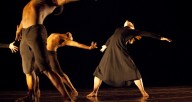“It’s a family.” This is what kept coming up in my conversation with Nicole Gifford, co-producer of Harvest Chicago Contemporary Dance Festival (HCCDF)—one of the longest-running contemporary dance festivals in Chicago—which will celebrate its tenth anniversary starting this weekend. Since 2010, Gifford and Melissa Mallinson have gathered dance artists from around the world at the Ruth Page Center for the Arts to “share and celebrate the work of practicing contemporary dance artists and companies,” said Gifford in an interview. The festival came about as a response to the closing of other larger dance festivals following the 2008-2009 recession. Gifford and Mallinson—who met when they were dancing for choreographer Jennifer Sandoval—were both looking to recreate community. “We had a really great group of dance friends. We were always challenging and inspiring each other and wanted to do more. [Apart from] choreographing and dancing, we were always trying to find new outlets to be a part of. We created the festival for people like us, who weren’t necessarily emerging artists and weren’t an established organization, but independent artists.” Gifford shared.
This year’s tenth anniversary edition includes 19 artists and companies in two different weekends (September 20-21 and 27-28) at the Ruth Page Center for the Arts. To celebrate, Gifford and Mallinson have curated two bills full of festival veterans like James Morrow/The Movement (Virginia), RE|Dance Group (Chicago), and Dmitri Peskov (Utah); and newcomers such as Chicago-based J’Sun Howard, Sean Greene (California) and Brande Lee (Virginia). “It’s a beautiful mix. It’s like Thanksgiving dinner when everyone comes home…a cornucopia of dance family and friends. I’m excited to welcome returning and new dancers to celebrate together,” Gifford said.
As a festival veteran, James Morrow—b-boy and choreographer who began his career by stumbling in on a modern dance class at Southeastern Illinois University— is excited to return to HCCDF to celebrate such a big milestone. “What I love about the festival is that it is very eclectic, because there are so many different styles and genres represented. The fact that Melissa and Nicole are able to curate such a diverse show with national and international artists is such an important part of the Chicago dance scene that’s been missing,” said Morrow in an interview.
Morrow will be showing “We Don’t Dig Holes to Bury Ourselves,” a solo that “explores the cringeworthy justifications of war.” The piece comes from Morrow’s personal and visceral memory of 9/11 and its aftermath, the way the tragic event is permeated into the bodies of those who were alive to witness it, and the relationship that today’s generation has with the event. “The first time I performed this piece was after 9/11…and I remember how surreal it felt watching the second tower go down. I teach at a university and many of the students don’t really have a reference to it except for Google. There’s a part of me that felt the need to bring it back,” Morrow explained. As someone who was first introduced to dance at 10 years old through b-boying and Chicago’s house scene, Morrow’s work explores house dance and modern/contemporary techniques in his work as a spiritual experience. Morrow goes on, “Street dance doesn’t get the recognition it deserves. Watching [artists like] Ron K. Brown’s ‘Grace’ in New York…gave me permission, it empowered me, to use the vernacular that I grew up doing, and put it on the concert stage.”
J’Sun Howard—a newcomer to the festival—echoes this sentiment with “At The Altar: It May Not Be My Time.” It’s a new iteration of his “aMoratorium,” a dance commission for the Art Institute’s exhibition “Charles White: A Retrospective” that honored the work and legacy of Chicago visual artist, Charles Wilbert White.
“The work still explores black church and spirituality around death, but specifically [about] that space after you have passed on, and what that space looks like for black males,” Howard explained in an interview. “As a duet, I am interested in what happens when you are at a crossroads with one of your brothers. Do you acknowledge each other? Do you belong together? Are you both guides or followers? Until you figure out what it is, you figure it out.”
As a newcomer to Harvest, Howard is looking forward to networking with other artists from around the country and seeing how his piece comes into conversation with the other works Gifford and Mallinson have curated this year. When asked about how he feels his work pushes the boundaries of contemporary dance, Howard responded, “Research. In order for me to understand what is contemporary in anything, I have to do research in terms of how our bodies move, how black bodies move in relation to another black body, or in relation to being ‘gazed’ at. For me, pushing that boundary is trying to access authenticity, one’s presence. [It’s] not necessarily about codified movement, but what comes forth out of the body in the moment.”
Gifford expressed that learning about each of the artists’ personalities and work is what most excites her about this year. “I’m excited to celebrate [everyone], and we’re putting a lot of work in to make it a really wonderful celebration.
--
The Harvest Chicago Contemporary Dance Festival runs Sept. 20-28 at the Ruth Page Center for the Arts. Tickets are $25, available by clicking the link below.


